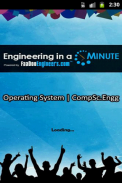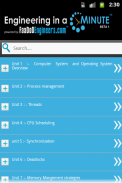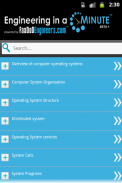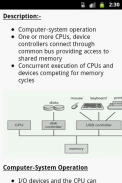






Operating System - OS

Descrizione di Operating System - OS
Welcome to an exciting world of operating system (O/S). The Basics of Operating System is a free app with listing of notes on the introduction of the OS and covers the basics of how system software works
Usually a part of computer science, software engineering, programming and information technology courses but open for all enthusiasts to learn the basics.
The App covers more than 125 topics on the subject divided into 14 units.
The App brings all the interesting topics in a flashcard which is easy to browse, revise and come back to another topic to learn. Some of topics Covered in this application are:
1. Overview of computer operating systems
2. Computer System Organization
3. Operating System Structure
4. Distributed system
5. Operating System services
6. System Calls
7. System Programs
8. Operating System Generation
9. Operating-System Services
10. Operating-System Interface
11. Process Management
12. Process Control Block
13. Schedulers
14. Context switch
15. Operations on Processes
16. Interprocess Communication
17. Sockets
18. Remote Procedure Calls
19. Remote method invocation
20. Threads
21. Scheduling Criteria
22. Scheduling Algorithms
23. Multithreading Models
24. Thread Libraries
25. Threading Issues
26. CPU scheduling
27. Multiple-Processor Scheduling
28. Symmetric Multithreading
29. Thread Scheduling
30. Solaris Scheduling
31. Windows XP Scheduling
32. Linux Scheduling
33. Algorithm Evaluation
34. Process Synchronization
35. The Critical Section Problem
36. Synchronization Hardware
37. Semaphores
38. Classic problems of synchronization
39. Monitors
40. Atomic Transactions
41. Deadlocks
42. Deadlock Characterization
43. Methods for handling deadlocks
44. Deadlock Prevention
45. Deadlock Avoidance
46. Banker’s algorithm
47. Deadlock Detection
48. Recovery from Deadlock
49. Memory Management Strategies
50. Address Binding
51. Logical versus Physical Address Space
52. Dynamic Linking and Loading
53. Swapping
54. Contiguous Memory Allocation
55. Fragmentation
56. Paging
57. Hardware Support in paging
58. Shared Pages
59. Segmentation
60. Virtual memory
61. System libraries
62. Demand Paging
63. Copy-on-Write
64. Page Replacement
65. FIFO Page Replacement
66. Optimal Page Replacement
67. LRU Page Replacement
68. Enhanced Second-Chance Algorithm
69. Allocation of Frames
70. Thrashing
71. Working-Set Model
72. Page-Fault Frequency
73. Memory-Mapped Files
74. Shared Memory in the Win32 API
75. Allocating Kernel Memory
76. Slab Allocation
77. File Concept
78. File Operations
79. File Types
80. Directory Structure
81. Directory
82. File System Mounting
83. File System Structure
84. File System Implementation
85. Directory Implementation
86. Free Space Management
87. Recovery
88. Log-Structured File Systems
89. Network file systems
90. Network file systems protocol
91. Magnetic Disks
92. Disk Structure
93. Disk Attachment
94. Disk Scheduling
95. Disk Management
96. Boot Block
97. Bad Blocks
98. Swap-Space Management
99. I/O Systems
100. Polling
101. Direct Memory Access
102. Application I/O Interface
103. Kernel I/O Subsystem
104. Transforming I/O Requests to Hardware Operations
105. Streams
106. Performance
107. Protection
108. Access Matrix
109. Implementation of Access Matrix
110. Access Control
111. Language-Based Protection
112. The Security Problem
113. Malicious codes
114. System and Network Threats
115. Cryptography as a Security Tool
116. Authentication
117. Key Distribution
118. User Authentication
119. Firewalling to Protect Systems and Networks
IMPORTANT LINKS
Feedback: Share your feedback at essyengineering@gmail.com
Social links
Facebook : https://www.facebook.com/EngineeringEasy/
Twitter : https://twitter.com/easyengineerin
Website:http://www.engineeringapps.net/
Wishing you a very happy learning
</div> <div jsname="WJz9Hc" style="display:none">Benvenuti in un mondo emozionante di sistema operativo (O / S). Le basi del sistema operativo è una applicazione gratuita con la lista di note per l'introduzione del sistema operativo e copre le basi di come funziona il software di sistema
Di solito una parte della scienza informatica, ingegneria del software, corsi di informatica di programmazione e di ma aperto a tutti gli appassionati per imparare le basi.
L'App copre più di 125 argomenti sul tema suddiviso in 14 unità.
L'App porta tutti gli argomenti interessanti in una flashcard, che è facile da navigare, rivedere e tornare a un altro argomento per imparare. Alcuni degli argomenti trattati in questa applicazione sono:
1. Panoramica dei sistemi operativi informatici
2. Organizzazione Computer System
Struttura 3. Sistema Operativo
4. Sistema distribuito
5. Servizi del sistema operativo
6. chiede di sistema
7. Programmi di sistema
8. Sistema operativo Generation
9. Servizi del sistema operativo
10. Operating-System Interface
Gestione 11. Processo
12. Procedimento Control Block
13. Schedulatori
interruttore 14. Contesto
15. Operazioni su Processi
Comunicazione 16. Interprocess
17. Prese
18. Remote Procedure Calls
19. Remote Method Invocation
20. Le discussioni
21. Criteri di pianificazione
22. Algoritmi di scheduling
23. I modelli multithreading
24. Biblioteche Discussione
25. problemi di threading
scheduling 26. CPU
27. Multiple-Processor Scheduling
28. simmetrica multithreading
Programmazione 29. Discussione
30. Solaris Scheduling
31. Windows XP Scheduling
Programmazione 32. Linux
33. Algoritmo di valutazione
Sincronizzazione 34. Processo
35. La sezione critica problema
36. Sincronizzazione Hardware
37. semafori
38. classici problemi di sincronizzazione
39. Monitor
40. transazioni atomiche
41. deadlock
42. Deadlock Caratterizzazione
43. Metodi per la gestione deadlock
44. Deadlock Prevenzione
45. Deadlock Avoidance
46. Bankerà ¢ â,¬â "¢ s algoritmo
47. Deadlock Detection
48. Recupero da deadlock
49. Strategie di gestione della memoria
50. Indirizzo Binding
51. Logico rispetto Spazio indirizzo fisico
52. collegamento dinamico e caricamento
53. Swapping
54. contigua allocazione di memoria
55. La frammentazione
56. paging
57. Supporto hardware di paging
58. Pagine Condivise
59. Segmentazione
60. La memoria virtuale
61. librerie di sistema
62. demand paging
63. copy-on-write
Sostituzione 64. Page
Sostituzione 65. FIFO Pagina
Sostituzione 66. ottimale Pagina
Sostituzione 67. LRU Pagina
68. In secondo luogo-Chance algoritmo avanzato
69. Assegnazione di Frames
70. Thrashing
71. Working-Set Modello
Frequenza 72. Page-Fault
73. memory-mapped file
74. memoria condivisa nelle API Win32
Memoria 75. Allocazione Kernel
76. Lastra Allocation
Concetto 77. File
78. Operazioni sui file
79. Tipi di file
Struttura 80. Directory
81. Directory
Sistema 82. File di montaggio
Sistema 83. Struttura del file
Sistema 84. file di implementazione
Attuazione 85. Directory
86. Gestione Spazio libero
87. Recupero
88. file system strutturato a log
89. file system di rete
90. Protocollo di rete file system
91. dischi magnetici
Struttura 92. Disco
Allegato 93. Disco
Programmazione 94. Disco
Gestione 95. Disco
96. blocco di avvio
97. Blocchi Bad
Gestione 98. Swap-Space
99. I / O Sistemi
100. Polling
101. Direct Memory Access
102. Applicazione Interfaccia I / O
103. Kernel I / O sottosistema
104. I / O richieste Trasformare I alle operazioni hardware
105. Streams
106. Prestazioni
107. Protezione
108. Accesso Matrix
109. Attuazione di accesso Matrix
Controllo di accesso 110.
111. Protezione Language-Based
112. Il problema di sicurezza
113. codici maligni
114. Sistema e di rete minacce
115. La crittografia come strumento di sicurezza
116. autenticazione
117. Key Distribution
Autenticazione utente 118.
119. Firewalling per proteggere i sistemi e reti
LINK IMPORTANTI
Risposte: Condividi i tuoi commenti al essyengineering@gmail.com
legami sociali
Facebook: https://www.facebook.com/EngineeringEasy/
Twitter: https://twitter.com/easyengineerin
Sito web: http: //www.engineeringapps.net/
Augurandovi un apprendimento molto felice</div> <div class="show-more-end">


























